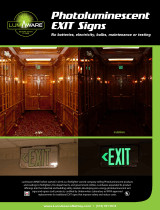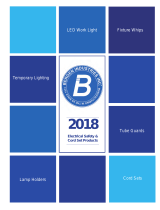
LED Buyer’s Guide
Overview
LEDs are but one of the many types of bulbs within lighting technology. Understanding these
technologies and their differences can help bring the topic of LEDs into context.
All About LEDs
LED stands for “light-emitting diode.” LEDs that emit visible light come in several different colors and
brightnesses. They can be utilized in several different components, including household lighting,
indicator lights, electronic devices, and certain screens (LED screen is simply an LCD screen backlit
by LEDs). LEDs have been around for quite some time, but were too expensive and not bright
enough for in-home lighting. LEDs still have a slightly higher cost than other lighting technologies,
but can last for decades and use a fraction of the electricity compared to traditional bulbs.
Why LEDs Are Different From Other Light Bulbs
In order to understand what makes LEDs different from other light bulbs, it is necessary to have a
general understanding of how other lighting technologies work. (i.e. incandescent and CFL).
Incandescent
Incandescent bulbs are the traditional light bulbs that were popularized by Thomas Edison. They
create light by forcing electricity through a tiny tungsten coil. The coil, or filament, resists the
electricity, and creates both light and heat. Eventually, the filament burns out. Since approximately
90% of the electricity being used by these bulbs is turned into heat rather than visible light, they are
very inefficient at producing light. Incandescent lights are now seeing a gradual decrease due to
their noticeable electricity consumption over newer technologies.
Fluorescent Lights and CFLs (Compact Fluorescent Lights)
Fluorescent lights are tubes filled with fluorine gas which have no filament. Instead, they pass
electricity through the gas, causing the glass itself to glow. Fluorescent lights produce much less
heat and use less electricity to last longer than incandescent bulbs. Consequently, the light has a
slightly, natural blue tint that tends to flicker. All fluorescent bulbs contain at least a small amount of
mercury (as low as 1.4mg). Compact fluorescent lights, or CFLs, are designed to fit into light fixtures
originally intended for incandescent bulbs and often times have filters to make their light appear
more like incandescent.
LEDs
LEDs provide safer, and more energy-efficient lighting experience than past technologies. Their
durable design does not contain hazardous materials, which ensures an all-around safe use. Like
CFL's, LEDs are also relatively cool and will not emit heat the way incandescent bulbs do. While
their cost is slightly more than both CFLs and incandescent bulbs, their long lifespan change the way
consumers buy bulbs. Traditional incandescent bulbs were considered to be a “convenience good”
like paper towels or soap. This is because consumers purchased them on a regular basis. LEDs can
last as long as some lamps do, depending on how often they are used. Therefore, the initial
investment lasts a consumer much longer than other light bulbs.

While some people prefer the color of incandescent lights, LEDs generally outperform incandescent
bulbs and even CFLs. When comparing the efficiency of LED bulbs to others, look at the lumens per
watt measurement. Lumens measure light intensity while watts measure electrical usage. The higher
the ratio, similar to miles per gallon (MPG) on a car, the more light any given bulb emits for the same
amount of electricity. This creates a significant difference between LEDs and other bulbs.
Comparing LEDs, CFLs, and Incandescent Lights
The table below shows the wattage, lumens to watts ratio, and expected life-span (assuming the
bulb is used for eight hours every day) for three bulbs. Each bulb is capable of putting out roughly
1700 lumens. This is the brightness of a 100 watt incandescent bulb, or an ordinary living room
lamp. The three bulbs are an incandescent, a CFL, and an LED. Notes on each technology type are
also included.
Feature
Incandescent
CFL
LED
Wattage
100
25
11
Lumens Per
Watt
12
62
89
Life
Expectancy
(years)
0.3
3.5
25
Other
Warm color, but
produces a lot of
heat
Inexpensive, but
contains mercury
Slightly more expensive
but long lasting; comes
in multiple colors
Research shows that many bulbs are used fewer than eight hours a day; an LED that is used less
often could last well over 20 years.
Selecting LED Bulbs
Color
The older technology bulbs generally make light in only one color; additional colors are created by
tinting the shell of the bulb. LEDs are different in that they do not need tints and filters. Depending on
the design, an LED can create light in many different colors. Some can even produce more than one
color. While some LED bulbs do produce a slightly bluish white light, others produce a much
warmer, soft white tone. For indoor use, warm white is the preferred choice as cooler tones can look
unflattering. Red, green, and blue LED bulbs are also available to meet your lighting needs.

When choosing a color, the two considerations are color rendering, which means how well the light
shows the true color of objects, and temperature. The higher the temperature, the brighter the white.
Bulb temperature is measured in Kelvin's, and warm white LEDs are usually between 2,500 and
3,000 K, while bright white is between 4,500 to 5,000 K. Color rendering is measured on a scale of 1
to 100 and LEDs can score as high as 85.
Light Intensity (aka "Brightness")
Light intensity is measured in lumens. To replace an incandescent or CFL bulb with an LED bulb,
look for one that produces the same number of lumens as the old bulb. Do not use watts as a
measure of brightness. As noted, watts actually measure electricity usage, which varies between
different bulb technologies.
It is more energy efficient to replace an incandescent with an LED immediately rather than waiting
for the old bulb to burn out. However, if replacing all the bulbs in the house with LED bulbs is too
expensive, begin with the light fixtures that are used the most often.
Conclusion
Buying LED bulbs is a more energy-efficient alternative to using other bulb types. Consumers should
make sure the LED bulb will fit in the fixture where it will be used. First determine what base
configuration, shape, and size will fit, and then decide how many lumens and what color works best.
After that, the only task left is to find a good deal on a bulb. LED bulbs are more expensive than
traditional bulbs, but they last much longer and are a good long-term investment. Once a light fixture
is matched with a good bulb, it may not need to be replaced for upwards of 20 years. It is important
to get the right kind of bulb that provides the best energy-efficiency and color for the space it
illuminates.
-
 1
1
-
 2
2
-
 3
3
Ask a question and I''ll find the answer in the document
Finding information in a document is now easier with AI
Other documents
-
 LumAware CLR-GR-FM-FC-T Specification
LumAware CLR-GR-FM-FC-T Specification
-
Leviton DDMX1-BLZ Operating instructions
-
Leviton DDMX1-BLZ FAQ
-
 Bergen Industries GL50MC123MPC User manual
Bergen Industries GL50MC123MPC User manual
-
Leviton DZ1KD-1BZ Installation guide
-
Leviton DDE06-BLZ FAQ
-
Lutron SCL-153P-IV Installation guide
-
Osram 510853 Datasheet
-
Leviton DW1KD-1BZ Installation guide
-
Lutron CTCL-153PDH-2-LA Installation guide




